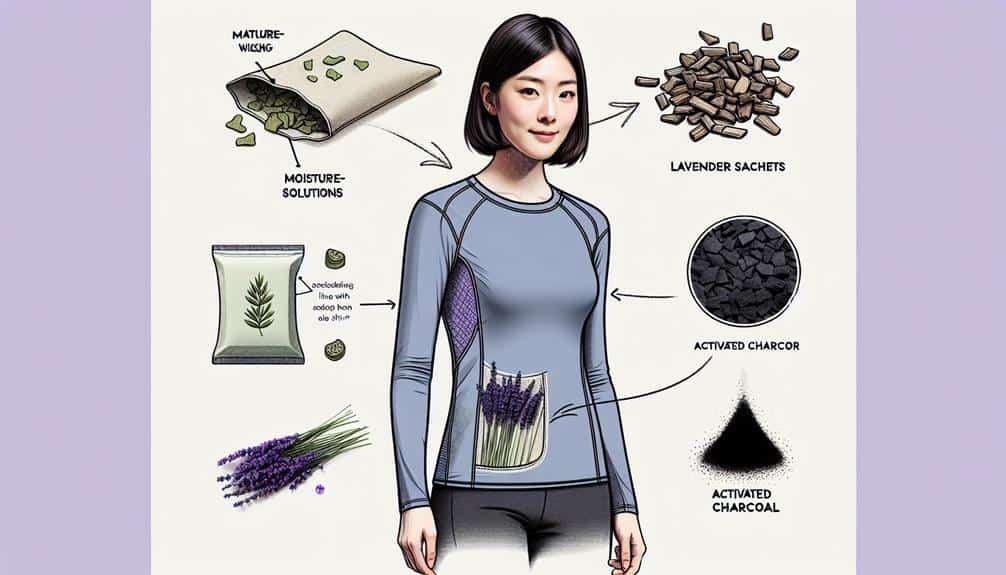To keep moisture-wicking shirts odor-free, wash them on a gentle cycle with cold water. Avoid fabric softeners and bleach. Use activewear detergent to eliminate sweat and odors effectively. Invert shirts before washing to protect the outer surface. Air-dry or use low heat in the dryer to prevent damage. Store them in breathable containers to prevent moisture buildup. Don't use plastic bags to avoid musty smells. Rotate shirts regularly and wash promptly after use. Adding white vinegar to the wash cycle can help eliminate lingering odors. Follow these tips for odor-free activewear.
Key Points
- Wash shirts promptly after each use to prevent odor buildup.
- Use mild detergent and avoid fabric softeners for optimal odor control.
- Add white vinegar to the wash cycle to eliminate lingering odors effectively.
- Ensure shirts are completely dry before storing to prevent mold and mildew.
- Rotate shirts regularly to prevent excessive wear and allow them to breathe between uses.
Understanding Odor in Activewear
To effectively manage odor in activewear, understanding the science behind bacterial growth and sweat absorption is essential. Fabric science plays a pivotal role in determining how odors develop in moisture-wicking shirts worn during an active lifestyle. Moisture-wicking fabrics are designed to pull sweat away from the skin to the outer surface of the garment, where it can evaporate quickly. However, this moisture can create an ideal environment for bacteria to thrive. When bacteria come into contact with sweat, they break it down into acids, leading to unpleasant odors.
Certain fabrics, such as polyester or nylon, are more prone to bacterial growth due to their synthetic nature and tight weave. These fabrics provide a hospitable environment for bacteria, allowing them to multiply rapidly. Understanding the properties of different fabrics can help in selecting materials that are less conducive to bacterial growth, hence reducing odor buildup in activewear.
Benefits of Odor-Resistant Technology
Understanding the benefits of odor-resistant technology can significantly improve the effectiveness of managing odor in activewear, especially in moisture-wicking shirts.
Here are three key advantages of incorporating odor-resistant technology in your moisture-wicking shirts:
- Odor Fighting Fabrics: Odor-resistant technology in moisture-wicking shirts is crafted to combat the growth of odor-causing bacteria. These fabrics are designed with special properties that hinder the proliferation of microbes, thereby reducing the development of unpleasant odors even after intense physical activities.
- Long Lasting Freshness: Odor-resistant technology helps in preserving the freshness of your moisture-wicking shirts over an extended period. By preventing the buildup of odors, these fabrics ensure that your activewear remains odor-free for longer durations, allowing you to stay comfortable and confident throughout your workout sessions.
- Enhanced Performance: With odor-resistant technology, moisture-wicking shirts can maintain their functionality and performance even after multiple uses. By preserving the fabric quality and preventing odors, these shirts can sustain their moisture-wicking properties, ensuring excellent comfort and performance during your workouts.
How to Properly Wash Moisture Wicking Shirts
Properly washing moisture-wicking shirts is crucial to maintain their odor-resistant properties and performance capabilities over time. When washing these specialized garments, choose a gentle cycle with cold water to safeguard the fabric. Avoid using fabric softeners or bleach, as these can clog the fibers and diminish their moisture-wicking abilities. Select a detergent specifically formulated for activewear to efficiently eliminate sweat and odor without leaving residue behind.
For washing techniques, invert the shirts before placing them in the washing machine to safeguard the outer surface and preserve the effectiveness of the moisture-wicking technology. Additionally, consider washing similar fabrics together to prevent abrasion and pilling. When it comes to drying methods, air-drying is the best choice to maintain the integrity of the fabric and prevent shrinkage. If using a dryer, opt for a low heat setting to prevent damage to the moisture-wicking properties of the shirt.
Tips for Storing Odor-Free Apparel
Consider utilizing breathable storage containers to safeguard your odor-free apparel from moisture and odors. When it comes to storing odor-free apparel, proper storage solutions are essential for maintaining the freshness of your clothing. Here are three tips for storing your odor-free apparel effectively:
- Breathable Storage Containers: Opt for storage containers made from breathable materials such as cotton or linen. These containers allow air circulation, preventing moisture buildup and potential odors in your apparel.
- Avoid Plastic Bags: Refrain from storing your odor-free apparel in plastic bags as they can trap moisture, leading to musty smells over time. Instead, choose breathable garment bags or fabric storage bins.
- Use Cedar Blocks or Lavender Sachets: Incorporate natural odor prevention methods by placing cedar blocks or lavender sachets in your storage containers. Cedar blocks absorb moisture and odors, while lavender sachets add a pleasant scent to your apparel.
Maximizing Odor Control in Everyday Use
To effectively maximize odor control in everyday use, implement strategic laundering practices and utilize odor-neutralizing products. When it comes to odor prevention, start by washing moisture-wicking shirts promptly after each use. Use a mild detergent that targets odors without leaving residue behind. Avoid fabric softeners as they can decrease the fabric's moisture-wicking capabilities. Additionally, consider adding white vinegar to the wash cycle to help eliminate lingering odors effectively.
Daily maintenance is essential for keeping moisture-wicking shirts odor-free. Make sure shirts are completely dry before storing them to prevent mold and mildew growth, which can lead to unpleasant smells. If possible, hang shirts to air out after wear before tossing them in the laundry hamper. Consider using odor-neutralizing sprays or sachets in your closet to keep stored shirts fresh. Finally, rotate your shirts regularly to prevent excessive wear on one shirt, allowing each to fully dry and breathe between uses. By incorporating these practices into your daily routine, you can effectively maximize odor control and keep your moisture-wicking shirts smelling fresh.
Frequently Asked Questions
Can Moisture Wicking Shirts Be Worn Multiple Times Before Washing Without Developing Odors?
Ever wonder about wearing moisture-wicking shirts multiple times, sans odors? Proper care is key. Employ odor prevention techniques like airing out, using antimicrobial detergents, and avoiding fabric softeners. Follow fabric care tips diligently.
Are There Any Natural Remedies or DIY Solutions for Removing Odors From Moisture Wicking Shirts?
To combat odors in moisture-wicking shirts, explore natural remedies like vinegar or baking soda. DIY solutions can include soaking the garment in a mixture of water and these substances to remove unpleasant scents effectively.
How Long Does the Odor-Resistant Technology Typically Last in Moisture Wicking Shirts?
You might think odor-resistant technology lasts forever, but in reality, its effectiveness diminishes over time. Regular maintenance techniques such as proper washing with odor-fighting detergents and air drying can help prolong the odor-resistant durability of moisture-wicking shirts.
Can Using Fabric Softener or Dryer Sheets Affect the Odor-Resistant Properties of Moisture Wicking Shirts?
Using vinegar or baking soda can help maintain the odor-resistant properties of moisture-wicking shirts. Avoid fabric softener and dryer sheets, as they can diminish these properties. Vinegar and baking soda are effective alternatives for odor control in technical fabrics.
Are There Specific Types of Deodorant or Antiperspirant That Should Be Avoided When Wearing Moisture Wicking Shirts to Maintain Odor Control?
Want to maintain odor control with moisture wicking shirts? Be cautious with deodorant types; some may not be as effective. Check antiperspirant ingredients; certain ones can impact the shirt's odor-resistant properties negatively. Choose wisely.



